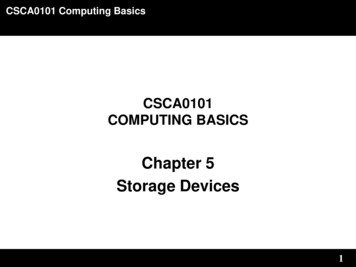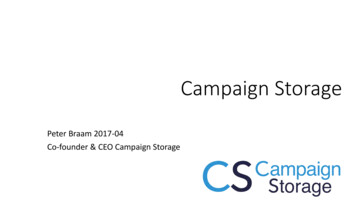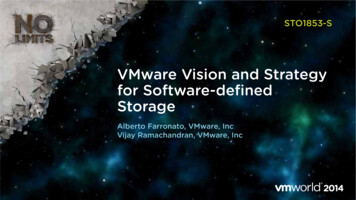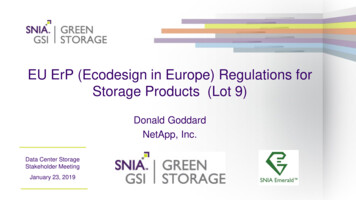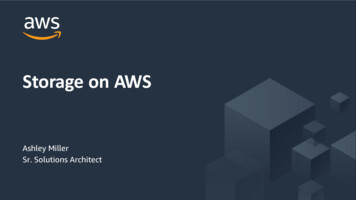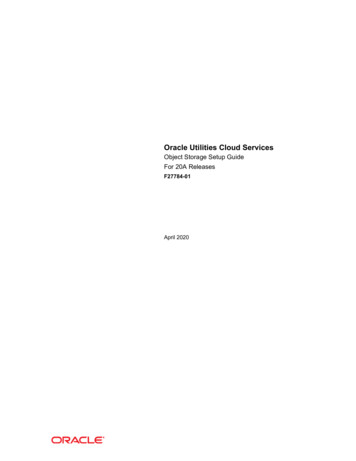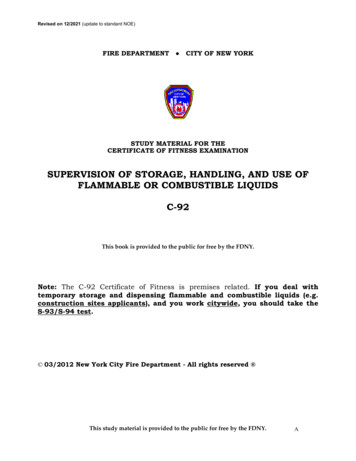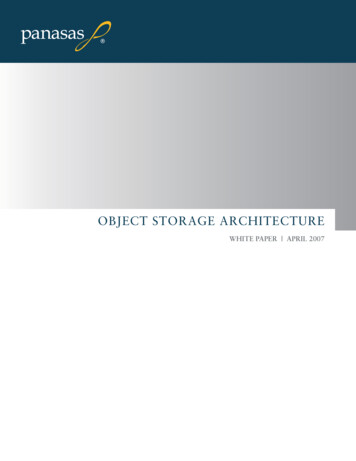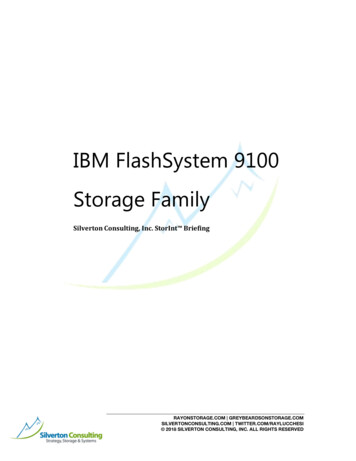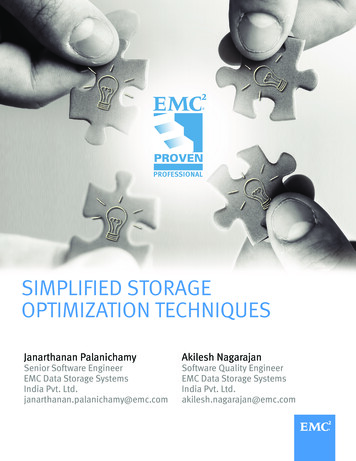
Transcription
Data StoragePhilip J. CwynarUniversity of PittsburghSchool of Information Sciencespcwynar@pitt.eduData Storage
Outline Collecting data Relational Databases NoSQL Databases Key-value databases Document databases Column-family stores Graph databases Beyond NoSQL DatabasesData Storage
Collecting DataData Storage
Collecting dataRelational DatabasesNoSQL DatabasesBeyond NoSQL DatabasesBig Data’s 3VVolumeVarietyVelocityData Storage
Data Storage
Collecting dataRelational DatabasesNoSQL DatabasesBeyond NoSQL DatabasesThe quantity of data collected The New York Stock Exchange generates about oneterabyte of new trade data per day. Facebook hosts approximately 10 billion photos, takingup one petabyte of storage. Ancestry.com, the genealogy site, stores around 2.5petabytes (1015) of data. The Internet Archive stores around 2 petabytes (1015) ofdata, and is growing at a rate of 20 terabytes (1012) permonth. The Large Hadron Collider near Geneva, Switzerland,will produce about 15 petabytes (1015) of data per year.Reference: Tom White, Hadoop: The Definitive Guide, Third Edition, 2012Data Storage
Structured DataI suspect the term SD came from the name for a commonlanguage used to access DBs,called Structured Query Language, or SQL.SQL provides a well-defined way for applications to managedata in a DB.The little snippet of SQL code here illustrates how anapplication could retrieve all rows from a table called Bookwhere the Price is greater than 100 and request that theresult be sorted in ascending order by title.Data Storage
Storing Data: Relational DatabasesData Storage
Collecting dataRelational DatabasesNoSQL DatabasesBeyond NoSQL DatabasesRelational databases: Definition Relational database: A set of relations Relation: Made up of 2 parts:– Schema: specifies name of relation plus name and typeof each columnCustomer(id:int, name:string, gender:string, email:string)– Instance: a table, with rows and u2ChirayuMalechw@pitt.edu– Can think of a relation as a set of rows (tuples)Reference for this section: NoSQL distilled: A brief guide to the emergingworld of polyglotp ersistence / Pramod J Sadalage, Martin Fowler.Data Storage
Relational databases: Data ModelEntity Relationship Diagram Collecting dataRelational DatabasesNoSQL DatabasesBeyond NoSQL DatabasesData model oriented around a relational database (using UML notation)Data Storage
Collecting dataRelational DatabasesNoSQL DatabasesBeyond NoSQL DatabasesRelational databases: Data ModelTypical data using RDBMS data modelData Storage
Collecting dataRelational DatabasesNoSQL DatabasesBeyond NoSQL DatabasesRelational databases: Integrity constraints (ICs) IC: condition that must be true for any instance of thedatabase, e.g., domain constraints– ICs are specified when schema is defined– ICs are checked when relations are modified A legal instance of a relation is one that satisfies allspecified ICs.– DBMS should not allow illegal instancesData Storage
Collecting dataRelational DatabasesNoSQL DatabasesBeyond NoSQL DatabasesRelational databases: Primary key constraints A set of fields is a key for a relation if:1. No two distinct tuples can have same value in allkey fields, and2. This is not true for any subset of the key» If part 2 is false, then it is super key. K is a candidate key if K is minimal. Among all candidate keys we must select one thatbecomes the Primary KeyData Storage
Relational databases: Foreign key constraintsCollecting dataRelational DatabasesNoSQL DatabasesBeyond NoSQL Databases Foreign key: Set of fields in one relation that is used torefer to a tuple in another relation (must correspond to aprimary key of the second relation) If all foreign key constraints are enforced, referentialintegrity is achievedData Storage
Collecting dataRelational DatabasesNoSQL DatabasesBeyond NoSQL DatabasesRelational databases: Normalization 1st Normal Form: make tables flat (all elements atomic) 2nd Normal Form: Every non-prime attribute depends ona candidate key or another non-prime attribute 3rd Normal Form: some redundancy but dependencypreserving BCNF (Boyce Codd Normal Form): no redundancy butnot dependency preserving Redundancy might lead to update anomalies Note: we are going to break normalization(denormalize) laterData Storage
Collecting dataRelational DatabasesNoSQL DatabasesBeyond NoSQL DatabasesRelational databases: Query language A major strength of the relational model:– Supports simple, powerful querying of data (SQL)» DDL (Data Description Language): create, drop, alter» DML (Data Manipulation Language): insert, update,delete, select» DCL (Data Control Language): grant, revoke» TCL (Transaction Control Language): commit, rollback Queries can be written intuitively, and the DBMS isresponsible for efficient evaluation– The key: precise semantics for relational queries– Allows the optimizer to extensively re-order operations,and still ensure that the answer does not change.Data Storage
Relational databases: ExampleCollecting dataRelational DatabasesNoSQL DatabasesBeyond NoSQL DatabasesMovieGenresGenresMoviesData Storage
Collecting dataRelational DatabasesNoSQL DatabasesBeyond NoSQL DatabasesRelational databases: Query ExampleData Storage
Collecting dataRelational DatabasesNoSQL DatabasesBeyond NoSQL DatabasesRelational databases: ACID transactions Transaction is a unit of work performed within a databasemanagement system against a database Atomicity – all or nothing Consistency – bring database from one valid state to another Isolation - the intermediate state of a transaction is invisibleto other transactions Durability - after a transaction successfully completes,changes to data persist and are not undone, even in theevent of a system failure.Data Storage
Structured Data Warehousing ApproachesBill Inmon – “Father of Data Warehousing”----Enterprise Data WarehouseRalph Kimball – “Father of Business Intelligence”----Data Mart / Star SchemaData Storage
BillInmon’s enterprise data warehouse approach (the top-down design):A normalized data model in 3NF is designed first. Then the dimensional datamarts, which contain data required for specific business processes or specificdepartments are created from the data warehouse. RalphKimball’s dimensional design approach (the boCom-up design):The data marts for reporDng and analysis are created first; these are thencombined together to create a broad data warehouse.Data Storage
Bill Innmon – Operational Data Store (ODS)Data Storage
Ralph Kimball – Star SchemaData Storage
Star Schema – Data Mart DesignRalph KimballData Storage
Star Schema – Data Mart DesignRalph KimballThe star schema architecture is the simplest data warehouse schema. It iscalled a star schema because the diagram resembles a star, with pointsradiating from a center.The center of the star consists of fact table and the points of the star arethe dimension tables.Usually the fact tables in a star schema are in third normal form(3NF)whereas dimensional tables are de-normalized.Despite the fact that the star schema is the simplest architecture, it is mostcommonly used nowadays and is recommended by Oracle.Data Storage
Pros and cons of both the approachesData Storage
Storing Data: NoSQL DatabasesData Storage
Unstructured Data TypesHere is a limited list of types of unstructured data: Emails WordProcessing Files PDF files Spreadsheets Digital Images Video Audio Social Media PostsData Storage
Collecting dataRelational DatabasesNoSQL DatabasesBeyond NoSQL DatabasesNoSQL databasesNoSQL databases:– Not using the relational model– Schemaless– Running well on clusters– Tend to be open-source– List of NoSQL databases (more than 150!):http://nosql-database.org/Data Storage
Collecting dataRelational DatabasesNoSQL DatabasesBeyond NoSQL DatabasesWhy are NoSQL databases interesting?Two primary reasons: Application development productivity Large-scale dataData Storage
Collecting dataRelational DatabasesNoSQL DatabasesBeyond NoSQL DatabasesNoSQL databases: Data models Key-value databases:– BerkeleyDB, LevelDB, Memcached, Project Voldemort,Redis, Riak, Document databases:– CouchDb, MongoDB, OrientDB, RavenDB, Terrastore, Column-family stores:– Amazon SimpleDB, Cassandra, Hbase, Hypertable, Graph databases:– FlockDB, HyperGraphDB, Infinite Graph, Neo4J,OrientDB, Otherhttp://en.wikipedia.org/wiki/Data warehouseData Storage
Collecting dataRelational DatabasesNoSQL DatabasesBeyond NoSQL DatabasesAggregate data model: Example DDD: Domain-Driven Design Apparently easier to program Definitely, makes it easier to store and process data onmultiple computer ientedDatabase.htmlData Storage
Collecting dataRelational DatabasesNoSQL DatabasesBeyond NoSQL DatabasesAggregate data model// in [{"city":"Chicago"}]}// in uctId":27,"price": 32.45,"productName": "NoSQL txnId":"abelif879rft","billingAddress": {"city": "Chicago"}}],}An aggregate data edDatabase.htmlNoSQL distilled : a brief guide to the emerging world ofpolyglot persistence / Pramod J Sadalage, Martin Fowler.Data Storage
Collecting dataRelational DatabasesNoSQL DatabasesBeyond NoSQL DatabasesAggregate data model// in customers{"customer": {"id": 1,"name": "Martin","billingAddress": [{"city": "Chicago"}],"orders": ":27,"price": 32.45,"productName": "NoSQL txnId":"abelif879rft","billingAddress": {"city": "Chicago"}}],}]}}An aggregate data edDatabase.htmlNoSQL distilled : a brief guide to the emerging world ofpolyglot persistence / Pramod J Sadalage, Martin Fowler.Data Storage
Collecting dataRelational DatabasesNoSQL DatabasesBeyond NoSQL DatabasesAggregate data model: Pros and cons Cons:– It is often difficult to draw aggregate boundaries well– Does not support ACID transactions (thus sacrificesconsistency)– Some queries are easier (to the point of being practical)but others may be really hard (e.g., to get to productsales history, you’ll have to dig into every aggregate inthe database). Pros:– Helps greatly with running on a cluster: This is the mainargument for NoSQL ql-or-rdbms-are-we-asking-the-right-questions/Data Storage
Collecting dataRelational DatabasesNoSQL DatabasesBeyond NoSQL DatabasesAggregate data model: Key points An aggregate is a collection of data that we interact withas a unit. Key-value, document, and column-family databases canall be seen as forms of aggregate-oriented database. Aggregates make it easier for the database to managedata storage over clusters.NoSQL distilled : a brief guide to the emerging world ofpolyglot persistence / Pramod J Sadalage, Martin Fowler.Data Storage
Storing Data: NoSQL Database:Key-Value DatabasesData Storage
Collecting dataRelational DatabasesNoSQL DatabasesBeyond NoSQL DatabasesKey-value databases A key-value store is a simple hash table– Get the value for the key– Put a value for a key– Delete a key from the data store The value is a blob You can think of such databases as databaseswith only one table, which has two columns: IDand Value.NoSQL distilled : a brief guide to the emerging world ofpolyglot persistence / Pramod J Sadalage, Martin Fowler.Data Storage
Collecting dataRelational DatabasesNoSQL DatabasesBeyond NoSQL DatabasesKey-value databases: RiakTerminology comparison:RDBMSRiakDatabaseRiak clusterTableBucketRowKey-valueRowID (at least in Oracle)key1,000s of startups, enterprises, and organizationshave deployed Riak for their production systems.References: http://wiki.basho.com/Riak.htmlNoSQL distilled : a brief guide to the emerging world ofpolyglot persistence / Pramod J Sadalage, Martin Fowler.Data Storage
Collecting dataRelational DatabasesNoSQL DatabasesBeyond NoSQL DatabasesKey-value databases: Riak Writing to the Riak bucket using the store API:Bucket bucket getBucket(bucketName);IRiakObject riakObject bucket.store(key, value).execute(); Getting value for the key using fetch API:Bucket bucket getBucket(bucketName);IRiakObject riakObject bucket.fetch(key).execute();byte[] bytes riakObject.getValue();String value new String(bytes);References: http://wiki.basho.com/Riak.htmlNoSQL distilled : a brief guide to the emerging world ofpolyglot persistence / Pramod J Sadalage, Martin Fowler.Data Storage
Collecting dataRelational DatabasesNoSQL DatabasesBeyond NoSQL DatabasesKey-value databases: RiakRiak provides an HTTP-based interface (this allows all operations tobe performed from a web browser or command line):– curl -X PUT HTTP://127.0.0.1:8098/riak/images/1.jpg -H "Contenttype: image/jpeg" --data-binary @images.jpg– curl -i HTTP://127.0.0.1:8098/riak/images/1.jpg– curl -v -X POST -d '{ }' -H "Content-Type:application/json“ http://127.0.0.1:8098/riak/test/1– curl -i HTTP://127.0.0.1:8098/riak/test/1References: http://wiki.basho.com/Riak.htmlNoSQL distilled : a brief guide to the emerging world ofpolyglot persistence / Pramod J Sadalage, Martin Fowler.Data Storage
Collecting dataRelational DatabasesNoSQL DatabasesBeyond NoSQL DatabasesKey-value databases: Usage When to use:– Storing session information– User profiles, preferences– Shopping cart data When not to use– Relationships among data– Multi-operation transactions– Query by data– Operations by setsReferences: http://wiki.basho.com/Riak.htmlNoSQL distilled : a brief guide to the emerging world ofpolyglot persistence / Pramod J Sadalage, Martin Fowler.Data Storage
Storing Data: NoSQL Database:Document DatabasesData Storage
Collecting dataRelational DatabasesNoSQL DatabasesBeyond NoSQL DatabasesDocument databases Documents are the main concept here– DB stores and retrieves documents Documents stored are similar to each other but do nothave to be exactly the same– Schemaless Documents are stored in the value part of the keyvalue storeNoSQL distilled : a brief guide to the emerging world ofpolyglot persistence / Pramod J Sadalage, Martin Fowler.Data Storage
Collecting dataRelational DatabasesNoSQL DatabasesBeyond NoSQL DatabasesDocument databases: What is document? One document: Another document:¡ { "firstname": "Martin",¡ {"firstname": "Pramod","likes": [ "Biking", "Photography" ],"citiesvisited": [ "Chicago","lastcity": "Boston","London", "Pune", "Bangalore" ],"lastVisited":"addresses": [}{ "state": "AK","city": "DILLINGHAM","type": "R"},{ "state": "MH",Schema can differ significantly"city": "PUNE",among documents in the"type": "R" }same database.],This was not possible in"lastcity": "Chicago"}RDBMS databases.NoSQL distilled : a brief guide to the emerging world ofpolyglot persistence / Pramod J Sadalage, Martin Fowler.Data Storage
Collecting dataRelational DatabasesNoSQL DatabasesBe basesNoSQL DatabasesBeyond NoSQL DatabasesColumn-oriented data model Column-oriented organizations are more efficient when anaggregate needs to be computed over many rows but only for anotably smaller subset of all columns of data, because readingthat smaller subset of data can be faster than reading all data. Column-oriented organizations are more efficient when newvalues of a column are supplied for all rows at once, becausethat column data can be written efficiently and replace oldcolumn data without touching any other columns for the rows. Row-oriented organizations are more efficient when manycolumns of a single row are required at the same time, andwhen row-size is relatively small, as the entire row can beretrieved with a single disk seek. Row-oriented organizations are more efficient when writing anew row if all of the column data are supplied at the same time,as the entire row can be written with a single disk seek.http://en.wikipedia.org/wiki/Column-oriented DBMSData Storage
Collecting dataRelational DatabasesNoSQL DatabasesBeyond NoSQL DatabasesColumn-oriented data model Data indexed by:– (row:string, column:string, time:int64) à string #of distinct column families - small (in hundreds) unbounded number of columns Data processing is pushed to the applicationNoSQL distilled : a brief guide to the emerging world ofpolyglot persistence / Pramod J Sadalage, Martin Fowler.Data Storage
Collecting dataRelational DatabasesNoSQL DatabasesBeyond NoSQL DatabasesColumn-family databasesConceptual View:Row KeyTime Stamp“com.cnn.www”t9anchor:cnnsi.com “CNN”“com.cnn.www”t8anchor:my.look.ca “CNN.com”“com.cnn.www”t6contents:html “ html ”“com.cnn.www”t5contents:html “ html ”“com.cnn.www”t3contents:html “ html ”Physical ViewColumn Family anchorColumn Family contentsColumn Family contentsColumn Family anchorRow KeyTime StampColumn Family anchor“com.cnn.www”t9anchor:cnnsi.com “CNN”“com.cnn.www”t8anchor:my.look.ca “CNN.com”Row KeyTime StampColumn Family contents“com.cnn.www”t6contents:html “ html ”“com.cnn.www”t5contents:html “ html ”“com.cnn.www”t3contents:html “ html ”http://hbase.apache.org/book.html#datamodelData Storage
Collecting dataRelational DatabasesNoSQL DatabasesBeyond NoSQL DatabasesColumn-family databases: HBase HBase is the Hadoop database– Distributed, scalable, big data store Use HBase when you need random, real-time read/writeaccess to your Big Data Goal is to host very large tables:– billions of rows X millions of columns HBase is an open-source, distributed, versioned, columnoriented store modeled after Google's Bigtablehttp://hbase.apache.org/Data Storage
Collecting dataRelational DatabasesNoSQL DatabasesBeyond NoSQL DatabasesColumn-family databases: HBase No SQL-like query language– Java API– HBase Shell» create ‘test’, ‘cf’» put ‘test’, ‘row1’, ‘cf:a’, ‘value1’» put ‘test’, ‘row2’, cf:b’, ‘value2’» get ‘test’, ‘row1’ COLUMNCELLcf:atimestamp 1288380727188,value value1 HBql – separate project to simplify the usage of tart.html#shell exercisesData Storage
Collecting dataRelational DatabasesNoSQL DatabasesBeyond NoSQL DatabasesColumn-family databases: Usage When to use:– Event logging– Content management systems, blogging platforms– Expiring usage– Need aggregate using, e.g., SUM or AVG When not to use– Frequent changes to the database (inserts anddeletes maybe expensive)References: http://wiki.basho.com/Riak.html;NoSQL distilled : a brief guide to the emerging world ofpolyglot persistence / Pramod J Sadalage, Martin Fowler.Data Storage
Storing Data: NoSQL Database:Graph DatabasesData Storage
Collecting dataRelational DatabasesNoSQL DatabasesBeyond NoSQL DatabasesGraph databasesAn example graph structureNoSQL distilled : a brief guide to the emerging world ofpolyglot persistence / Pramod J Sadalage, Martin Fowler.Data Storage
Collecting dataRelational DatabasesNoSQL DatabasesBeyond NoSQL DatabasesGraph databasesRelationships with propertiesNoSQL distilled : a brief guide to the emerging world ofpolyglot persistence / Pramod J Sadalage, Martin Fowler.Data Storage
Collecting dataRelational DatabasesNoSQL DatabasesBeyond NoSQL DatabasesGraph Databases: Neo4j Node creation:– Node martin graphDb.createNode();– martin.setProperty("name", "Martin");– Node pramod graphDb.createNode();– pramod.setProperty("name", "Pramod"); Relationship creation:– martin.createRelationshipTo(pramod, FRIEND);– pramod.createRelationshipTo(martin, FRIEND);NoSQL distilled : a brief guide to the emerging world ofpolyglot persistence / Pramod J Sadalage, Martin Fowler.Data Storage
Collecting dataRelational DatabasesNoSQL DatabasesBeyond NoSQL DatabasesGraph Databases: Neo4j, QueryingCreate index:Transaction transaction graphDb.beginTx();try {Index Node nodeIndex rtin, "name", martin.getProperty("name"));nodeIndex.add(pramod, "name", } finally {transaction.finish();}Relationship creation:Node martin nodeIndex.get("name", "Martin").getSingle();allRelationships martin.getRelationships();incomingRelations martin.getRelationships(Direction.INCOMING);NoSQL distilled : a brief guide to the emerging world ofpolyglot persistence / Pramod J Sadalage, Martin Fowler.Data Storage
Collecting dataRelational DatabasesNoSQL DatabasesBeyond NoSQL DatabasesGraph Databases: Neo4j, Querying Traverse the graphs at any depth:– Node barbara nodeIndex.get("name", "Barbara").getSingle();– Traverser friendsTraverser barbara.traverse(Order.BREADTH FIRST,StopEvaluator.END OF GRAPH,ReturnableEvaluator.ALL BUT START NODE,EdgeType.FRIEND,Direction.OUTGOING); Finding paths between two nodes:– Node barbara nodeIndex.get("name", "Barbara").getSingle();Node jill nodeIndex.get("name", "Jill").getSingle();PathFinder Path finder es(FRIEND,Direction.OUTGOING),MAX DEPTH);Iterable Path paths finder.findAllPaths(barbara, jill);NoSQL distilled : a brief guide to the emerging world ofpolyglot persistence / Pramod J Sadalage, Martin Fowler.Data Storage
Collecting dataRelational DatabasesNoSQL DatabasesBeyond NoSQL DatabasesGraph Databases: Neo4j, Cypher QLCypher query language:START beginingNode (beginning node specification)MATCH (relationship, pattern matches)WHERE (filtering condition: on data in nodes and relationships)RETURN (What to return: nodes, relationships, properties)ORDER BY (properties to order by)SKIP (nodes to skip from top)LIMIT (limit results)NoSQL distilled : a brief guide to the emerging world ofpolyglot persistence / Pramod J Sadalage, Martin Fowler.Data Storage
Collecting dataRelational DatabasesNoSQL DatabasesBeyond NoSQL DatabasesGraph Databases: Neo4j, Cypher QL Find all nodes connected to Barbara, either incoming or outgoing:– START barbara node:nodeIndex(name "Barbara")MATCH (barbara)--(connected node)RETURN connected node When we are interested in directional significance:– For incoming relationshipMATCH (barbara) -- (connected node)– For outgoing relationshipMATCH (barbara) -- (connected node)NoSQL distilled : a brief guide to the emerging world ofpolyglot persistence / Pramod J Sadalage, Martin Fowler.Data Storage
Collecting dataRelational DatabasesNoSQL DatabasesBeyond NoSQL DatabasesGraph Databases: Neo4j, Cypher QL Match can also be done on specific relationships usingthe :RELATIONSHIP TYPE convention and returning the requiredfields or nodes:– START barbara node:nodeIndex(name "Barbara")MATCH (barbara)-[:FRIEND]- (friend node)RETURN friend node.name,friend node.location Query for relationships where a particular relationship propertyexists:– START barbara node:nodeIndex(name "Barbara")MATCH (barbara)-[relation]- (related node)WHERE type(relation) 'FRIEND'RETURN related node.name, relation.sinceNoSQL distilled : a brief guide to the emerging world ofpolyglot persistence / Pramod J Sadalage, Martin Fowler.Data Storage
Collecting dataRelational DatabasesNoSQL DatabasesBeyond NoSQL DatabasesGraph databases: Usage When to Use:– Connected Data– Routing, Dispatch, and Location-Based Services– Recommendation Engines When Not to Use– When you want to update all or a subset of entities– Not “graph” data modelNoSQL distilled : a brief guide to the emerging world ofpolyglot persistence / Pramod J Sadalage, Martin Fowler.Data Storage
Collecting dataRelational DatabasesNoSQL DatabasesBeyond NoSQL DatabasesNoSQL databases: Summary Key-value databasesDocument databasesColumn-family storesGraph databasesData Storage
Collecting dataRelational DatabasesNoSQL DatabasesBeyond NoSQL DatabasesNoSQL Databases: Goals Not using the relational modelSchemalessRunning well on clustersAggregates – nested data stored togetherData Storage
Collecting dataRelational DatabasesNoSQL DatabasesBeyond NoSQL DatabasesNoSQL: Schemaless Relational DB:– You first have to define a schema for your database NoSQL:– Storing data is more casual:» Key-value store – allow any data under a key» Document DB – no restrictions on the structure ofthe document» Column-family DB – allow rows have differentcolumns, any data under any column» Graph DB – allow freely adding new edges andproperties to nodes and edgesData Storage
Collecting dataRelational DatabasesNoSQL DatabasesBeyond NoSQL DatabasesNoSQL: Schemaless Advantages:– Easy to handle changes– Easy to deal with non-uniform data» where each record has different set of fields Disadvantages:– Database remains ignorant of the schema» Can’t validate data types– Implicit schema in the application code» Bad and/or complicated code» Multiple application access the same databaseData Storage
Collecting dataRelational DatabasesNoSQL DatabasesBeyond NoSQL DatabasesNoSQL Databases – BASE properties Basically available: Use replication to reduce the likelihood of dataunavailability and use “sharding” (partitioning the data amongmany different storage servers) to make any remaining failurespartial. The result is a system that is always available, even ifsubsets of the data become unavailable for short periods of time. Soft state: While ACID systems assume that data consistency is ahard requirement, NoSQL systems allow data to be inconsistentand relegate designing around such i
NoSQL distilled : a brief guide to the emerging world of polyglot persistence / Pramod J Sadalage, Martin Fowler. Collecting data Relational Databases NoSQL Databases Beyond NoSQL Databases . Data Storage Key-value databases: Riak 1,000s of startups, enterprises, and organizations
